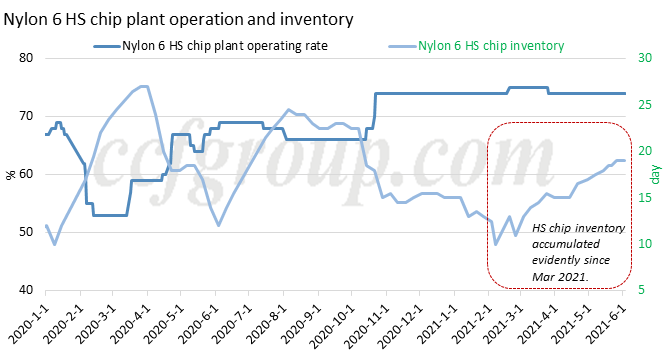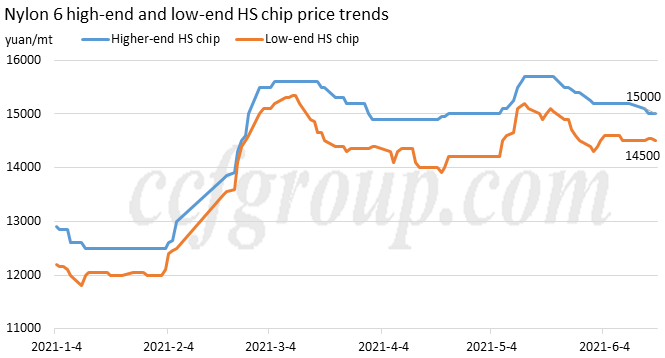Nylon 6 HS chip: latest chance of destock in June
Nylon 6 high-speed spinning (HS) chip market is less eye-catching as nylon 6 conventional-spinning (CS) chip market, as it is more static with a majority of transaction (close to 90%) through term contract. But in the past few months, nylon 6 HS chip market saw changes on the supply-demand structure and chip plants had suffering rising inventory pressure.
HS chip inventory built up continuously

Since March 2021, the inventory in nylon 6 HS chip plants had built up continuously. Though there were periodical intensive restock from downstream, the overall uptrend had not changed. Nylon 6 HS chip inventory was kept close to 20 days until early June. But most of the inventory was semi-dull chips, and dull chip supply was still tight.
Reasons for rising stock burden in HS chip plant
1. Downstream purchasing interest was low.

Transaction in nylon 6 HS chip market was concentrated in term contract, and only some low-end chips were sold in the spot. Since prices tumbled from March 2021, market was still waving at highs. In Mar-Apr, spot trades were still dominated by low-end HS chip, and the few available higher-grade sources were not advantageous in price over contract sources. Therefore, downstream was not active in restocking continuously.
In May, stock pressure became prominent, and this burdened some chip sellers’ prices down. But CPL market was in roller coaster, and quickly fell after mid-May. This made chip buyers unconfident, though HS chip spot prices had been comparatively low already.
2. End-user's demand concentrated in dull products
Until June, the average industrial inventory of nylon 6 HS chip was 20 days, among which mainstream semi-dull chip producers' stock was as high as 25-30 days or above. But there were merely any dull HS chip left, in the case that Juheshun and Fangyuan had already switched their production from semi-dull HS chip to dull chip. Apparently, these two plants’ adjustment did not help relieve the overall burden in semi-dull market.
Semi-dull and dull HS chip markets were in great disparity, mainly because end user’s demand concentrated for dull products. The most hot sold nylon filament products were dull FDY 20D/24F, 30D/12F, 40D/34F, 40D/7F, 70D/48F, and DTY20D/24F, 40D/36F, 50D/48F, and 70D/68F. In semi-dull market, demand was good for porous DTY 40D/36F and 50D/48F, but the proportion for the entire semi-dull market was small, and demand of other semi-dull products was affected by the high cost of spandex (nylon/spandex blended product). Filament plants were keen to produce dull products this year, rather than semi-dull ones, and that caused the difference in dull and semi-dull HS chips.
Chance to reduce inventory
Looking back over the three months after the Chinese Lunar New Year Festival, the intensive procurement for low-end and high-end HS chip was kept above 13,000yuan/mt and 14,000yuan/mt respectively cash, ex-works. The psychological price downstream considered proper to hoard raw materials had been floating as well. And the overall end user’s market is still in slack season and the overall buy power in downstream sectors is still conserved.
However, with upstream benzene and CPL market stabilized, downstream psychological rate seems to be close. When the positive expectation toward the third quarter of the year truly motivates end user’s demand for textile filament, it will naturally leads to increasing procurement for nylon 6 HS chip, and that will help HS chip plants release their stock burden.
As for how much downstream is going to buy or how stock is going down, it still depends on the raw material price rate, sea freight rate and RMB/USD exchange rate, which affect the export market.
June is still a slack season for Chinese textile industry and the export demand is uncertain as well. That is why when HS chip prices have dropped to a comparatively low rate, downstream still keeps cautious in restocking. In the short term, HS chip stock pressure will be existing for a while and they may consider to lower run rate further or shut for maintenance to balance when semi-dull HS chip inventory goes further higher.
- Top keywords
- Cotton Price
- Cotton Futures Price
- Cotton Futures
- CZCE
- PTA Futures Price
- Chemical Fiber
- Polyester Prices
- Wool price
- PTA Futures
- Shengze Silk
- China
- Yarn Price
- price
- China Textile City
- Fibre Price
- Benzene Price
- Cotton
- Index
- Cotton Index
- PTA
- fabric price
- NYMEX
- Top 10
- textile industry
- Spot Cotton
- Cotton Yarn
- Polyester Price
- Futures
- PTA Price
- cotton yarn price

